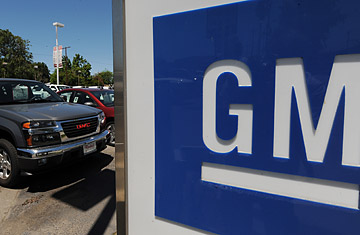
A GM dealership in Los Angeles
General Motors appears to be on a fast road to bankruptcy. CEO Fritz Henderson has already described a bankruptcy filing as "probable" as the Treasury's June 1 deadline for reorganizing the company draws near. Also, the fact that GM announced it was moving up its date for paying suppliers to May 28 from June 2 further suggests that bankruptcy is likely, says Brad Coulter of O'Keefe & Associates of Bloomfield Hills, Mich., which specializes in helping distressed manufacturing companies. "To me, it's a pretty clear indicator that they plan to file right around the June 1 deadline." At the same time, half a dozen senior GM executives have dumped shares, even though the stock has been trading for less than $2.
Meanwhile, the work necessary for averting a GM bankruptcy remains undone. Although the automaker is reportedly making progress on negotiations with the United Auto Workers (UAW), open issues remain, and GM even got into a public spat with the UAW over importing cars from China and Mexico. The union is now demanding more assurances as to what cars GM plans to build in the U.S. in the future. (See portraits of autoworkers.)
On a more positive note, the two sides have reportedly reached agreement on how to finance the Voluntary Employees' Beneficiary Association (VEBA), which was set up to fund retiree health-care benefits for GM's blue collar workforce. GM is said to be agreeing to deposit half the $20 billion it owes the VEBA and fund the other half with GM stock. The agreement appears to be very similar to the deal Chrysler LLC reached with the UAW. That deal put the UAW in control of the new Chrysler, with 55% of the stock. The union has also reportedly agreed to cut GM's labor costs, though neither the union nor GM would confirm the figures.
As part of the overall restructuring plan put forward by the company, 16 manufacturing facilities in the U.S. will be closed, including four assembly plants, according to Alan Reuther, director of the UAW's Washington office.
In a related move, GM announced on Friday that 500 dealers who handle Hummer, Saab and Saturn brands would be moved outside of GM's dealer network or terminated if a buyer for those nameplates cannot be found. Also on Friday, GM began notifying 1,100 GM dealers that their franchises will be terminated because they have failed to meet sales targets. Of GM's other 4,500 dealers, the automaker expects to cut 900, and it may use bankruptcy to get that done.
The biggest sticking point in any bid to avoid bankruptcy is the complexity of GM's debts. Chrysler's 40-odd creditors could fit into a large conference room. GM's creditors, however, could fill up most of the seats in the University of Michigan's football stadium. The bondholders include an estimated 127 major financial institutions, including banks, hedge funds and mutual funds, as well as 100,000 or so small holders that represent a cross section of American savers.
The bondholders complain that neither GM nor the Treasury has held any kind of serious discussion with them. In fact, CEO Henderson has described the offer to bondholders — 225 shares of GM stock for every $1,000 of bond face value — as a take-it-or-leave-it proposition.
